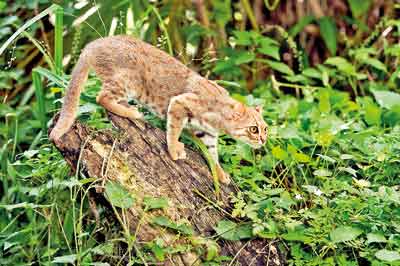A feline love that took him far and wide
A cat does have nine lives!
This is not just an old wife’s tale but comes from the “foremost” global authority on Small Cats, Dr. Jim Sanderson.
A more startling revelation follows……….cats have nine lives because whether it is a fall from a tall tree, a high building or anywhere else and they fracture any bones, their purring helps to cure the bone-breaks.

The Chinese Steppe Cat ‘captured’ by a camera-trap set by Dr. Jim Sanderson
Even though Dr. Sanderson, based in New Mexico in the United States of America, highlighted in his book on cats the fascinating fact which could move the frontiers of medicine that purring heals bones, it was a friend — who patented a device with the purring last year which has been tested on both cats and dogs – who went further.
His friend had uncovered a different detail, for he had found that it is not the purring that we hear which promotes fracture-healing but a higher decibel one in the multi-frequency purring, we humans do not hear, that does the job.
It is with this amazing piece of information that we wind up our two-hour interview with Dr. Sanderson for whom the lure has been the 33 wild species of Small Cats, some no bigger than one kilo, rather than the seven iconic Big Cats which saunter across many countries wowing people. The lion, tiger, jaguar, leopard, snow leopard, cheetah and puma have overshadowed the ‘small’ ones, and it is only due to the global support drummed up by Dr. Sanderson that the latter have got a tiny place in the sun.
“Sometimes we don’t even know that the wild Small Cats are around our homes, peering at us through trees,” he laughs, adding that they “hide all around us”.
Dr. Sanderson though has seen all but two of the 33 Small Cats spread across the world. The exceptions being the African Golden Cat which lives in the rainforests of Africa and the Marbled Cat which inhabits South and Southeast Asia.
It was in 1998 that he went in search of the Andean Cat, “by far the rarest and the most endangered” in the Americas, with the total population believed to be 2,500.
Why is it so threatened, he asks, answering that the Andean Cat is not fearful of humans and lets them approach it without slinking away into the wild. Couple that with the native people living in the high altitudes of the Andes attributing supernatural powers to it along with the belief that if the cat is killed these powers get transferred to humans. So the Andean Cat awaits its death without fear.
Recalling the first time he spotted the cat weighing about 4.5kg, along with a park guard in Bolivia, the knee-jerk reaction of the guard was to pick up a rock and only Dr. Sanderson’s frenzied yelling of “Para Para” (Stop, stop in Spanish) prevented the Andean Cat’s untimely and brutal death.
The rare photograph of the Andean Cat looking at them guilelessly published in the National Geographic caught the world’s attention and helped Dr. Sanderson to form the Andean Cat Alliance, a free standing non-profit organization.
The quest for the so-called Chinese Desert Cat “was a tricky one” for Dr. Sanderson who looked in the deserts of China to no avail.
One day, in Chengdu he spotted a Tibetan wearing a fur hat which was familiar – it was from the fur of the cat he had been searching for high and low. Overcome with excitement, he asked him from where he found the fur, to be told that the man was living in the high grasslands in Tibet.

All for the love of Small Cats: Dr. Jim Sanderson. Pic by Athula Devapriya
It took Dr. Sanderson a “brutal” 26-hour bus-ride with the Tibetan, withstanding not only the unpleasantness of motion-sick passengers throwing up all over him but also enduring a mix of odours of vomit, sweat and smoke to see with his own eyes this cat which lived in the high-elevation Alpine meadows and nowhere near a desert.
A camera trap he set after following a trail of its footprints leading to a cave and the photographs captured when it came out in the night were the very first. His triumph in tracking the cat led to a name change – now it is no more the Desert Cat but the Chinese Mountain or Steppe Cat.
For young Jim, it was a blind pet cat he had as a boy of about 12 living in New Jersey which opened up the interesting world of Small Cats. While other kids played baseball, Jim would carry ‘Shadow’ on his shoulders and place her in the garden, watching wide-eyed how she moved in the backyard navigating her way around trees and bushes, using senses other than sight and not bumping into anything.
“She could sense the surroundings by moving her whiskers even in total darkness,” he says with wonder, obvious even now.
In school and university, like many people, he followed the easy route, with his favourite subject being mathematics, leading to a job as a mathematician and computer scientist. “But always the cats were with me. Even though Shadow was long dead I could feel that she was with me, never far behind, ‘watching’ me with her whiskers, ears and nose,” he says.
Twenty years he held his job having secured a Ph.D in Mathematics but changed course after he sat for a post-graduate qualification in business administration and failed accounting twice, with him adept at formulae but not good at dealing in numbers like accountants.
Quitting his job, off he went to study the love of his life – Small Cats. “What motivated me was that a lot of things including studies and conservation were being done on Big Cats and there was much funding for them, but Small Cats were totally neglected,” he says.
He took his B.Sc in Biology and his Master’s in Ecology and then entered the University of Florida where he got his Ph.D from the Department of Wildlife Ecology and Conservation, studying both Science and Conservation.
During his doctoral studies that he radio-collared a Guigna, the smallest of the Small Cats in the Americas, in Chile. The cat had sneaked into a hen-house and been hit on the head with a broom. The injured cat had limped off and Dr. Sanderson soon found his body.
“It was painful, as I knew each and every cat I had collared as individuals. Each cat has its own personality and all are different from each other like people, some are shy, some are bold, some will go looking for you and some will hide from you. They are all unique. It’s profound. Some would get into trouble without even trying and some would never,” he says.
The study of Small Cats, starting in Chile taught him subtleties in their behaviour. There was a collared male cat that would go down to the ocean and sit around for hours. The mystery unfolded when he followed it – the cat would go to the beach at high-tide. As the waves rolled away, the shore-birds would pick out the crustaceans available aplenty. However, as the waves rolled back up again on the beach, the birds would scurry up, becoming an easy-catch for the cat hiding in the bushes.
The tid-bits were different for another ingenious cat which haunted a popular picnic area. Families, sometimes even with dogs, would tuck into food including juicy chicken pieces while the cat abided its time hidden in a tree, to pick up the scraps once they left.
Pointing out that the Big Cats can live anywhere, from Canada to the southern end of Chile, from Africa to Java and even in Siberia, in deserts, forests and even snow, if there is prey which they can hunt as they also eat whatever they want and they are ‘generalists’, Dr. Sanderson stresses that Small Cats, however, are ‘specialists’ and will die off if they lose their habitats.
“Take the Fishing Cat which eats fish and frogs even though people think that cats don’t like water and live in the wetlands. If the wetlands are gone the cats will go too,” he says.
Citing another example and showing us a beauty on his phone, Dr. Sanderson says that the Flat-headed Cat, a cousin of the Fishing Cat, is much smaller, endangered and lives in the peat-swamps of Sumatra and Borneo. It has never been studied but is under severe threat now, for the peat-swamps are being drained for the cultivation of palm oil trees.
“Their habitat is being converted into palm-oil plantations and the Flat-headed Cat has nowhere else to go,” he says, sending out a strong plea for the protection of the habitat of this Small Cat and all others too.
No single solution fits all, Dr. Sanderson said when delivering the monthly lecture of the Wildlife and Nature Protection Society (WNPS) on Thursday.
“Our programmes are long-term and constant vigilance is required. Threat mitigation includes repairing hen-houses, erecting warning signs along roads and working with local officials to prevent habitat destruction. Under our strategy: Threats, Interventions, Monitoring, Evaluation (TIME), we begin by ranking threats, then creating and implementing mitigation strategies,” added this Founder and Director of the Small Wild Cat Conservation Foundation who is also Programme Manager for Wild Cat Conservation at Global Wildlife Conservation and member of the IUCN Cat Specialist Group among many others.
| Ready to help protect our very own Small Cats | |
 The Rusty-spotted Cat photographed by Terry Whittaker at the Port Lympne Wild Animal Park in Kent, England There are three species of Small Cats in Sri Lanka. They are the Fishing Cat, the Jungle Cat and the Rusty-spotted Cat some of which may weigh something like 1kg. Two young local researchers have formed the group — ‘Small Cat Advocacy and Research’ (SCAR). While Anya Ratnayaka is studying the Fishing Cat in the urban wetlands of Colombo, Ashan Thudugala is doing so in Kandy. Dr. Jim Sanderson, who believes that locals in each country should be the ones who take up the responsibility of protecting these species, is always ready to lend a hand in advocacy. There are ‘4 Ps’ in this field – Passion, Patience, Persistence and an oath of Poverty, he adds. |


